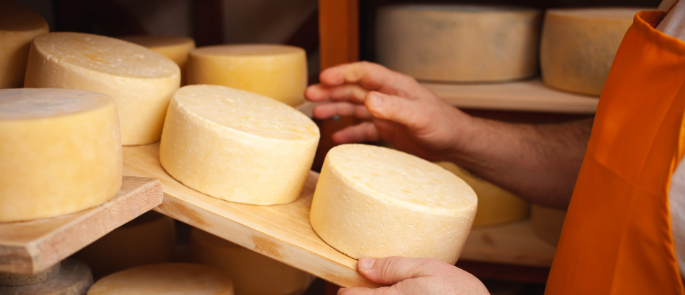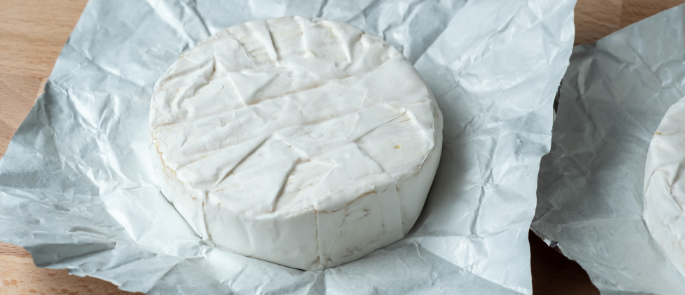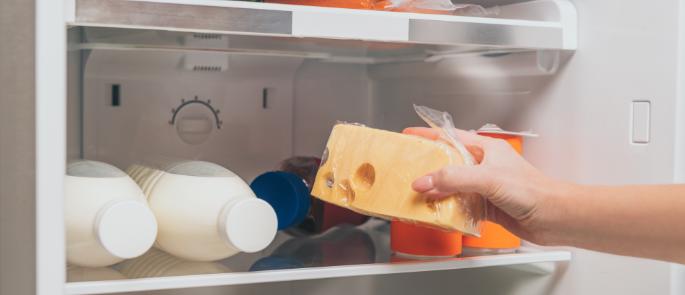How to Store Cheese
We all want to get the most out of our food and reduce the amount we waste by storing food properly to make it last longer. It’s fair to say that cheese in all its forms is incredibly popular with consumers, and so correct storage is essential so that we can all enjoy our cheese at its best.
The best cheese is much like a fine wine – an art form based on precise science. It is formed by carefully controlling the milk produced, the process of making the cheese and the storage methods applied to age it well. Artisan – or farmhouse – cheeses are made in ‘wheels’, which are then stored to mature. Once these wheels are cut open, the cheese is no longer able to mature in the same way, and correct storage is then essential so that we can appreciate the cheese in all its intended glory. Below, we’ll share our top tips on how to store cheese to ensure the best quality and encourage longevity.

What are the Best Cheese Storage Containers?
It’s important to note that there are a number of ways you can store your cheese, and this will be dependent on the type of cheese you have, for example, hard cheese or soft cheese. Some cheeses will be best kept in specific containers, whereas others will do just fine wrapped in cheese paper or clingfilm.
Bacteria require food and moisture to survive, and cheese with a lower moisture content tends to keep longer. Hard cheeses, such as parmesan, have a low moisture content, and because of this, hard cheeses are better wrapped in clingfilm rather than in waxed cheese paper (or baking parchment). This is because the paper will allow the air to pass through, and the cheese will dry out.

Soft cheeses have a higher moisture content and need to be able to breathe. Don’t wrap your soft cheeses in clingfilm as they won’t be able to breathe and they will ‘sweat’. If soft cheeses are prevented from breathing, they can build up ammonia gases which can taint the flavour and ruin your carefully selected purchase. Soft cheeses are therefore best wrapped in waxed cheese paper, baking parchment, or reusable waxed cloth, and then put in a plastic container. If you have a particularly tricky cheese, add a piece of dampened kitchen towel to the container and this will help regulate the atmosphere and the humidity inside the container. Keeping cheese in an airtight container will also help prevent the smell from escaping.
All cheese requires cool air and particular levels of humidity to stay at its best. In days of old, cheeses were often kept in stone barns that were usually dark, damp and provided a naturally cool environment. You can buy products that are specifically designed to replicate this type of environment, such as the cheese grotto. The modern take on the cheese grotto protects cheese and stores it at 75% humidity. These can be kept on the counter or in a fridge.
When storing your cheeses, it is important you follow the manufacturers’ guidelines and consume them before their use-by date. For most of us who don’t have access to special cheese stores, we tend to keep cheese in the fridge.
How to Store Cheese in the Fridge
Storing cheese in the fridge has the benefit of being able to hold it at a regular, cold temperature. This will limit the growth of bacteria and help your cheese stay fresh for longer. As we learned earlier, different types of cheese have different requirements when it comes to storage.
You’ll notice that many soft cheeses that are bought in supermarkets come in tubs with foil seals (e.g. Philadelphia and equivalents), or wrapped up in portions in liquid (e.g. mozzarella and feta), and even wrapped up waxed paper and placed in wooden collars (e.g. camemberts ready for the oven). These materials have been carefully selected to allow the cheese to be kept in the safest way for each of their own requirements. Wooden collars work really well in allowing cheese such as Tunworth to breathe, whilst inhibiting the growth of bacteria.
Once your cheese is wrapped up in the most appropriate way, you’ll need to think about where to put it in your fridge. We know that cheese benefits from consistency, and for that reason, you should keep it at the back of the fridge where the temperature and humidity are the most regulated. Try to avoid keeping cheese in the fridge door, as the constant opening and closing subjects it to hugely varying temperatures.
Want to Learn More?
Take a look at our extensive range of Food Hygiene and Safety Courses. Find everything from Level 2 Food Hygiene and Safety for Catering to Nutrition and Healthy Eating.

How to Store Cheese in the Freezer
Occasionally, you may need to store cheese in the freezer. This can be a great way to reduce waste and prolong the life of your cheese. Freezing cheese is safe to do and will extend its shelf life, but the process of freezing cheese will affect the texture and the flavour of the product.
Cheeses that have a high moisture content, for example, soft cheeses like brie and camembert, risk forming ice crystals when frozen, and the low temperatures can also suck the moisture out of them, causing them to dry out and become hard and unpalatable. It is not recommended that you freeze any cheese you want to enjoy eating on a cheeseboard.
However, freezing a block of cheddar that you intend to grate and use as an ingredient in your cauliflower cheese recipe is fine. If you do decide to freeze cheese, wrap it in waxed cheese paper or baking parchment and place it in an airtight container before popping it in the freezer and use it within 6 months.
Top Tip
When freezing food items, it’s a good idea to take stock of your freezer and check that it hasn’t become too iced up. This restricts the airflow and hinders the freezing process. Check out our article on how to safely defrost your freezer, if you feel now is the time to give your freezer some TLC.
Can You Eat Cheese That Has Mould On It?
Mould inside certain cheeses, such as stilton, is intentional. Blue and white vein mould is introduced into cheese in order to develop the flavour, and forms along the cracks and air pockets within the cheese. The blue (and white) moulds are different strains of the penicillin genus.
The Penicillium roqueforti strain has been specifically chosen for cheese because it adds flavour and it is what gives blue cheese its distinct look and flavour. Whereas Penicillium camemberti is used for surface-ripened cheeses, such as brie and camembert, which form the white furry outer edge. These penicillin moulds are completely harmless to eat because they do not produce the same mycotoxins that can be produced on other foods.

However, for some cheeses, mould is not a positive flavour-maker and, like any other food, it could make you feel unwell. Although you may follow the correct storage techniques, as outlined above, cheese will not last indefinitely, and you may see the formation of undesired mould.
Cheese which has a high moisture content, such as soft cheese, has a higher risk of going mouldy quicker, due to it providing a happy environment for bacteria to thrive. Bacteria need food and moisture to survive; whilst most bacteria are harmless or essential to our healthy digestive systems, some can be unpleasant.
You must try to control the risk of unwanted bacterial growth by limiting the flow of oxygen to the cheese, and by temperature regulation. Mould-ripened cheese can be susceptible to the bacteria Listeria monocytogenes, which causes an illness called listeriosis. This illness is especially dangerous to pregnant women. This is also where, especially in businesses and food-based settings, food hygiene training protocols need to be followed to reduce the risk of food poisoning.
We hope you have enjoyed this article and have learnt how to keep your cheese at its best for longer. If you have any further questions or wish to find out more information on the topics covered in this article, please don’t hesitate to get in touch with us at High Speed Training!
Further Resources:
- Online Food Hygiene Training
- Safe Temperatures for Food Storage: A Free Guide to Cooling and Chilling Times
- Do You Know Which Fridge Shelves You Should Store Your Food On?
- Food Safety Myths and Facts
- Answering Your FAQs About Egg Safety
- Understanding Factors Affecting the Shelf Life of Food Products
- How to Store a Cake







